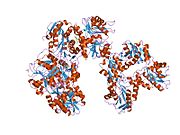| PRPSAP1 |
|---|
 |
| Available structures |
|---|
| PDB | Ortholog search: PDBe RCSB |
|---|
|
|
| Identifiers |
|---|
| Aliases | PRPSAP1, PAP39, phosphoribosyl pyrophosphate synthetase-associated protein 1, phosphoribosyl pyrophosphate synthetase associated protein 1 |
|---|
| External IDs | OMIM: 601249; MGI: 1915013; HomoloGene: 55687; GeneCards: PRPSAP1; OMA:PRPSAP1 - orthologs |
|---|
| Gene location (Human) |
|---|
 | | Chr. | Chromosome 17 (human)[1] |
|---|
| | Band | 17q25.1 | Start | 76,309,478 bp[1] |
|---|
| End | 76,384,521 bp[1] |
|---|
|
| Gene location (Mouse) |
|---|
 | | Chr. | Chromosome 11 (mouse)[2] |
|---|
| | Band | 11|11 E2 | Start | 116,361,671 bp[2] |
|---|
| End | 116,385,028 bp[2] |
|---|
|
| RNA expression pattern |
|---|
| Bgee | | Human | Mouse (ortholog) |
|---|
| Top expressed in | - parotid gland
- right lobe of thyroid gland
- gonad
- minor salivary glands
- left lobe of thyroid gland
- left testis
- right testis
- right lung
- ventricular zone
- right adrenal cortex
|
| | Top expressed in | - Paneth cell
- internal carotid artery
- epithelium of lens
- external carotid artery
- duodenum
- crypt of lieberkuhn of small intestine
- endothelial cell of lymphatic vessel
- left lobe of liver
- condyle
- jejunum
|
| | More reference expression data |
|
|---|
| BioGPS |  | | More reference expression data |
|
|---|
|
| Gene ontology |
|---|
| Molecular function | - enzyme inhibitor activity
- ribose phosphate diphosphokinase activity
- magnesium ion binding
- protein binding
- identical protein binding
- enzyme regulator activity
| | Cellular component | - ribose phosphate diphosphokinase complex
- cytoplasm
| | Biological process | - nucleotide biosynthetic process
- nucleobase-containing compound metabolic process
- negative regulation of catalytic activity
- 5-phosphoribose 1-diphosphate biosynthetic process
- purine nucleotide biosynthetic process
- regulation of catalytic activity
| | Sources:Amigo / QuickGO |
|
| Orthologs |
|---|
| Species | Human | Mouse |
|---|
| Entrez | | |
|---|
| Ensembl | | |
|---|
| UniProt | | |
|---|
| RefSeq (mRNA) | |
|---|
NM_002766
NM_001330503
NM_001366236 |
| |
|---|
| RefSeq (protein) | |
|---|
NP_001317432
NP_002757
NP_001353165 |
| |
|---|
NP_080640
NP_001391595
NP_001391596
NP_001391597
NP_001391598 |
|
|---|
| Location (UCSC) | Chr 17: 76.31 – 76.38 Mb | Chr 11: 116.36 – 116.39 Mb |
|---|
| PubMed search | [3] | [4] |
|---|
|
| Wikidata |
| View/Edit Human | View/Edit Mouse |
|

 2c4k: CRYSTAL STRUCTURE OF HUMAN PHOSPHORIBOSYLPYROPHOSPHATE SYNTHETASE-ASSOCIATED PROTEIN 39 (PAP39)
2c4k: CRYSTAL STRUCTURE OF HUMAN PHOSPHORIBOSYLPYROPHOSPHATE SYNTHETASE-ASSOCIATED PROTEIN 39 (PAP39)


















